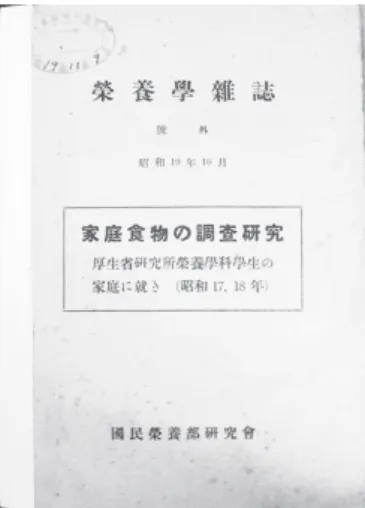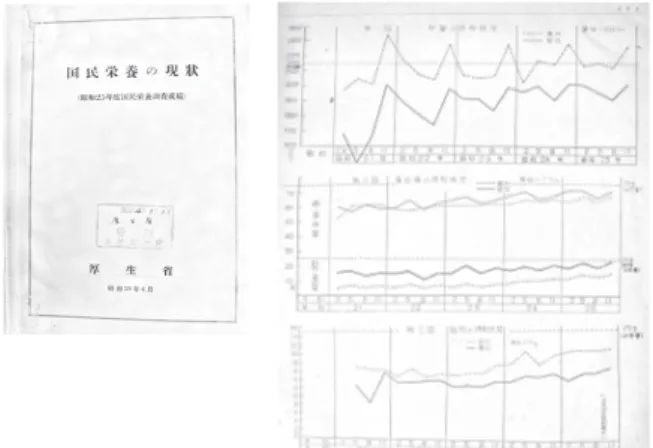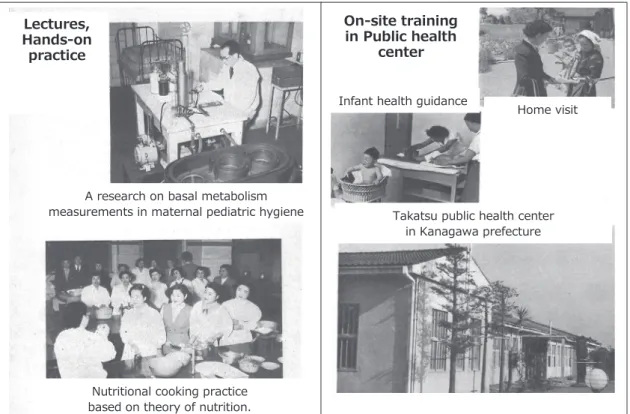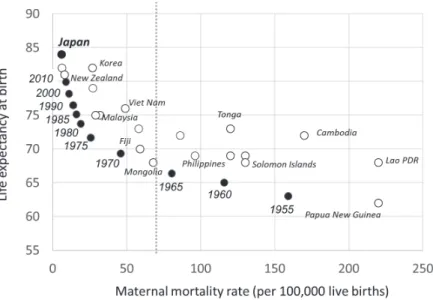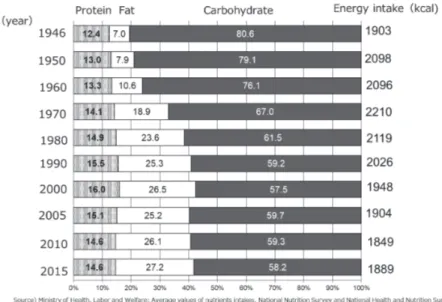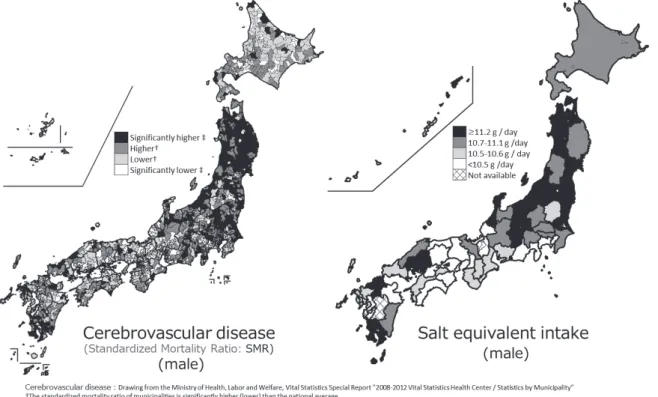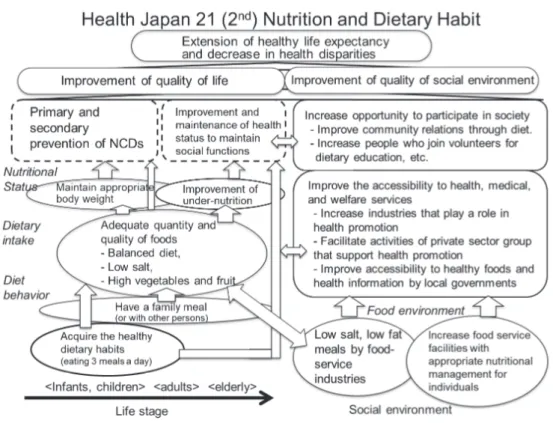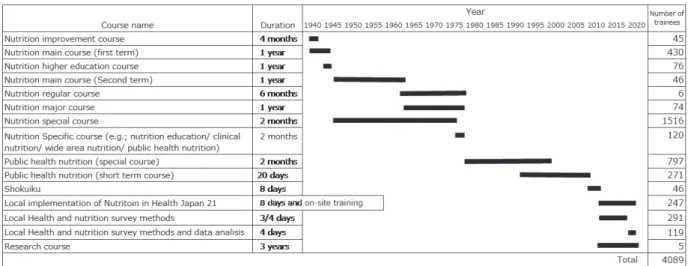Topics: Recent topics in public health in Japan 2021
Historical transition of the National Institute of
Public Health s contribution to Nutrition Policy in Japan
ISHIKAWA Midori
1), YOKOYAMA Tetsuji
1), SONE Tomofumi
2)1) Department of Health Promotion, National Institute of Public Health 2) National Institute of Public Health
Abstract
Using published literature, we described the historical transition of the contribution of the National In-stitute of Public Health (NIPH) to nutrition policies in Japan. We traced changes across five eras: 1) before World War II (1931–1938); 2) during World War II (1939–1946); 3) post-war reconstruction (1947–1960); 4) high economic growth and the asset price bubble (1960–1989); and 5) after the bubble: the Lehman shock and COVID-19 (1990–2020).
Before World War II, 1931–1938: Maternal and infant malnutrition and tuberculosis were leading health problems in this period. In 1937, the pre-war Public Health Center Act was enacted, tasking public health centers with providing guidance on nutrition improvement. In 1938, the Ministry of Health and Welfare (MoHW) was established in Japan, and the NIPH was set up to conduct training for public health personnel and perform research on public health matters. Urban and rural public health centers were established to provide on-site trainings.
During World War II, 1939–1946: Training for dietitians was conducted by the NIPH. The curriculum included lectures, hands-on practice, and on-site training in public health centers. Graduates conducted nu-trition improvement activities in local governments. When the war intensified, the trainees collected 3-day dietary records for their families as on-site training. This method and the results became the basic material for the National Nutrition Survey, which has been conducted in Japan since the end of the war.
Post-war reconstruction, 1947–1960: The Nutrition Division was established within the MoHW, and the Dietitians Act was put forward. NIPH training was targeted to staff of model prefectural public health cen-ters. Graduates informed the staff members of all public health centers in the prefecture of the training con-tents and played a key role in promoting nutritional measures at prefectural and municipal levels. In 1952, the Nutrition Improvement Act was enacted. NIPH training focused on creating a district for nutritional improvement practice that improved food habits by fostering community organizations, and research was conducted to evaluate the effect.
High economic growth and the asset price bubble, 1960–1989: The disease structure in Japan began to change in this period, and the Japanese diet shifted from the so-called Japanese dietary style to the West-ern dietary style. The MoHW formulated “National Health Promotion Countermeasures” to prevent life-style-related diseases. The policy enhanced health checkups and municipal health centers and secured pub-lic health nurse and dietitian manpower. Therefore, at the NIPH, collaborative training programs involving multiple professions were conducted to clarify health problems and make recommendations using survey data, with the cooperation of the local government. The NIPH studied and established the curriculum of
< Review >
Corresponding author: ISHIKAWA Midori 2-3-6 Minami, Wako, Saitama 351-0197, Japan. Tel: 048-458-6230
Fax: 048-458-6714
E-mail: ishikawa.m.aa@niph.go.jp [令和 3 年 1 月 7 日受理]
I. Introduction
The National Institute of Public Health (NIPH) has contributed to nutrition policies in Japan through training and research since the Institute’s establishment in 1938. However, few reports have systematically shown the his-torical transition of the NIPH’s contribution in this area. Therefore, this study aimed to present basic findings on the contribution of the NIPH to nutrition policies. The study traces the development of the field of public health nutrition and the historical transition of public health measures, high-lighting the NIPH’s ongoing contribution through training and research over more than 80 years.
II. Methods
First, we searched the NIPH library for books and re-ports published since 1930 that were related to nutrition policies and the NIPH. After reading these materials, we found that many publications focused on public health in general, and there were few explanations focusing on the field of nutrition specifically. Therefore, it was necessary to combine nutrition-related content from various books and reports.
Next, we extracted all sentences with the words “nutri-tion,” “dietary habits,” “dietitian,” “nutrition instructor,” “food,” or other nutrition-related words from the full text of the identified books and reports. We converted these
sen-tences into electronic data, retaining the precise language used in the original materials, which were sometimes in old Japanese. In the period of 1938 to 1947, when the NIPH was established, around the time of World War II, many events were described only partially. Thus, there were several cases where the background was unknown, and the described events could not be understood because of our lack of detailed knowledge of the era. It was also necessary to understand the food security conditions and lifestyles of people during different time periods. Therefore, we read books and reports covering different areas or governmen-tal organizations and prefecture-published reports about nutrition improvement published around the same year. This allowed us to better understand the meaning of the contents of the reports. We then supplemented the original sentences drawn out of the identified publications, adding explanations of their meaning. Furthermore, we noticed that the contents contained descriptions of both “nutritional problems” and “nutrition improvement activities,” and we organized the data according to these two categories.
Additionally, we found some English-language materials related to the public health administration of Japan’s Minis-try of Health and Welfare (MoHW), as well as several rele-vant NIPH reports submitted to the General Headquarters the Supreme Commander for the Allied Powers (commonly known as GHQ)—and international organizations after the end of the war. We collected these reports and identified their relevant content. These materials were useful for un-Public Health Nutrition Course. Subsequently, nutrition in public health came to be known as “kosyu-eiyo” (public health nutrition).
After the bubble: the Lehman shock and COVID-19, 1990–2020: In 2001, the MoHW was merged with the Ministry of Labour and renamed the Ministry of Health, Labour and Welfare. “Health Japan 21” was formulated, and the Health Promotion Act was passed to replace the Nutrition Improvement Act. In 2002, the NIPH was established as a new institution. The NIPH was created by integrating the former Institute of Public Health, the former National Institute of Health Services Management, and part of the Department of Oral Science from the National Institute of Infectious Diseases. Problems such as undernu-trition have arisen because of Japan’s aging population, and health inequalities have been identified in Japan. With these policy changes, new two courses have offered training on 1) local implementation of the Health Japan 21 nutrition plan and 2) local health and nutrition survey methods, and the researches on training tool development have implemented. In 2020, to prevent the spread of COVID-19, NIPH training sessions have been conducted remotely.
Final words: The NIPH’s training for public health personnel have been rooted in the needs of local gov-ernments, and the “development of training content to build a people-centered public health service system led by local residents” is needed. The NIPH has sought to create a system that acknowledges the impor-tance of training and research as “two wheels” to produce effectiveness, and they will continue to do this in the future.
keywords: National Institute of Public Health, Nutrition Policy, Training and research, Public health center,
Dietitian, People-centered public health service
derstanding and interpreting the situation in Japan in partic-ular historical periods.
To allow us to understand the trends in the nutrition policies in each era, all identified sentences were arranged in chronological order. During this process, for material from 1943 to 1955, we discovered that some publications expressed different meanings despite being about the same events. We were able to understand subtle changes in the policies related to nutrition improvement by reading and comparing these materials several times and reconsidering the contents together with the historical background. To un-derstand the described events in the context of Japan’s po-litical and economic historical transitions, we roughly clas-sified the data into the following five eras: 1) before World War II (1931–1938); 2) during World War II (1939–1946); 3) post-war reconstruction (1947–1960); 4) high economic growth and the asset price bubble (1960–1989); and 5) after the bubble: the Lehman shock and COVID-19 (1990–2020).
For the collection of the books and reports used in this study, we informed the staff of the NIPH library about the purpose of the study and got their cooperation in locating the relevant information. The library staff members were very knowledgeable about the history of the NIPH and were able to provide useful advice. We proceeded to draft a review, which we shared and discussed with government officials and experts knowledgeable about the history of Nutrition Policy.
III. Historical transition across five eras
1. Before World War II, 1931–1938: Establishment of the National Institute of Public Health in the Ministry of Health and Welfare based on the Public Health Center Act, the need for nutrition improve-ment in Japan, and the beginning of public health training for dietitians
In 1937, the pre-war Public Health Center Act was en-acted [1]. One duty of the public health center was estab-lished as to “provide guidance on improving nutrition.” The relevant contents of the Act were as follows: “The public health center will become a front-line guidance organiza-tion for nutriorganiza-tion improvement activities and work with the main office of prefectures and ordinance-designated cities to enhance the nutrition improvement ideas of the people. The center takes measures to improve the nutrition of the people to maintain and improve their health and physical strength.” Therefore, a dietitian was appointed to serve as a nutrition instructor [2].
In 1931–1934, before this law was enacted, a cold sum-mer caused agricultural damage to the six prefectures of Tohoku (an area in northern Japan), centered on Aomori, Iwate, and Miyagi. As a result, there were serious living difficulties in rural areas, and a large number of households had no choice but to survive by eating nuts and roots, there were many instances of young girls working instead of going to school, and the numbers of malnourished children increased rapidly [3].
During this period, the Japanese government put forward “encouragement of collaborative childcare and collaborative cooking in rural areas,” and dietitians were assigned to the
Figure 1 The crude death rate by cause of death in Japan from 1947 to 2017. Tuberculosis and pneumo-nia were the leading causes of death in 1940s. The cause-of-death structure in Japan began to change in 1960 s rapidly. The mortality rate from stroke, heart diseases and cancer were increased.
hygiene sections of the six prefectures of Tohoku. During the busiest parts of the farming season (e.g., rice planting and harvest), dietitians set up daycare centers in rural areas to take care of children as a solution to the labor shortage. They also designed kitchens for collaborative cooking, pre-pared nutritionally balanced menus, and provided meals to children [2].
Maternal and infant malnutrition and tuberculosis were serious health problems in Japan at this time. Figure 1 shows the crude death rate by cause of death in Japan from 1947 to 2015. Tuberculosis and pneumonia were the leading causes of death in 1940s.
Because of this situation, on the basis of the pre-war Health Center Act, Tokyo Prefecture was assigned one full-time dietitian who was to be actively involved in nutrition improvement guidance at nutrition improvement facilities (e.g., kindergartens, primary schools, and hospitals) as a preventive measure against infant death and tuberculosis.
A budget for nutrition improvement was also set up at this time [4]. To promote collaborative cooking in the rural ar-eas of Tokyo, the dietitian planned the lunch program using a shared kitchen, refurbished the water tanks of kindergar-tens, and provided meals to children (Appendix 1 (https:// www.niph.go.jp/journal/data/70-1/202170010005ap01.pdf)). A survey on the nutritional status of residents and a survey on the food preferences of rural women were conducted (Figures 2). In addition, nutritional guidance was given to pregnant women admitted to the hospital, and nutritional counseling was provided to mothers and children during health examinations at public health centers to address their nutritional problems.
In January 1938, the MoHW was established in Japan. The NIPH was then set up under the direct control of the Ministry [1,5] (Figure 3). The NIPH was tasked with being in charge of 1) conducting training for public health person-nel and 2) performing research on public health matters.
Figure 2 A nutrition improvement guidance was con-ducted by a dietitian of public health center to promote collaborative cooking in rural areas of Tokyo. (1937)
Figure 4 The Urban public health center (left building; later Tokyo Central public health center) and the Rural Health Center (right building; later Tokorozawa public health center at Saitama Prefecture) were estab-lished for on-site training. (1935-37)
Figure 3 The National Institute of Public Health (NIPH) was established under the Ministry of Health and Welfare in Tokyo. (1938)
The Urban Public Health Center (later Tokyo Central Public Health Center) and the Rural Health Center (later Tokorozawa Public Health Center in Saitama Prefecture) were established for on-site training in 1935–1937 (Figure 4). Most of the facilities and equipment required to establish these public health centers were financed by the Rocke-feller Foundation in the United States. The Department of Research and the Department of Training were established within the NIPH.
2. During World War II, 1939–1946: Development of a public health training curriculum for dietitians and the National Nutrition Survey
In 1939, World War II began. From 1940 to 1941, the first short-term training program for dietitians, a 4-month Nutrition Course, was held at the NIPH, and 45 partici-pants attended. This training was aimed at conveying the knowledge and skills necessary to provide nutritional im-provement guidance to housewives in local households and to plan and manage collaborative cooking in rural areas, as well as school lunches [1,5,6]. During the course lectures, it was explained that “collaborative cooking is nutritious food, good for the physical health, and fewer people get sick. And it is a hygienic cooking facility and economical meals and saves the hands of housewives.” Large-scale collabora-tive cooking was carried out in facilities such as factories, mines, schools, banks, and companies, whereas small-scale collaborative cooking included efforts by neighbors, groups of fire prevention workers, and temporary groups for air defense and security exercises [7].
Graduates of this NIPH training began to work in local government offices nationwide. In Tokyo Prefecture, the following research and nutrition improvement activities were carried out [5,8]: 1) research studies—the Nutrition Situation Survey (assessing, e.g., food intake, menus, and cooking methods), the Health Status Survey (including a parasite test, disease survey, and death survey), the Gener-al Hygiene Survey (assessing, e.g., toilet facilities, fertilizer use, and agricultural product cleaning), and other school nutrition surveys and 2) nutrition improvement activities— a) dissemination and enhancement of nutrition knowledge (e.g., through classes, tasting sessions, roundtable dis-cussions, and lectures) and b) on-site guidance regarding collaborative cooking for village nutrition improvement through primary and junior high schools, kindergartens, and daycare centers. Individual guidance for community households, the improvement of sanitary facilities, and the introduction of economical and nutritious foods were also provided.
Research studies at the NIPH based on training needs began to emerge around 1940, with studies conducted on
the nutritional requirements of Japanese people, Japanese foods and their nutrient composition, cooking methods and digestive absorption rates, and basal metabolism [1,9].
In December 1940, the National Institute of Nutrition (currently the National Institute of Health and Nutrition) and the NIPH were merged to deal with the intensification of colors caused by the War and to rationalize research op-erations and facilities. This merger continued until 1947.
In 1943, the Department of Nutrition was established within the NIPH, and a training program was begun for dietitians in the field of public health to manage community nutrition improvement. At that time, there was no training curriculum for public health nutrition in Japan, so the de-velopment of this curriculum was included in the training. A main course on nutrition (capacity: 100 persons, training period: 1 year) was designed to train public health dieti-tians, and a higher-level course (capacity: 30 persons, train-ing period: 1 year) was designed to train executive public health dietitians. The curriculum included lectures, hands-on practice, and hands-on-site training in public health centers [1,5].
However, in 1943, the war intensified, and it became dif-ficult to conduct on-site training through the public health centers. Therefore, the trainees returned to their home-towns for 7 days. While there, they collected a 3-day dietary record for their own families as on-site training. They mea-sured the actual food consumption of family members and
Figure 5 In 1943, the trainees collected 3-day dietary record for their families as on-site train-ing. The method and results of this survey were published the title of "Survey of Home Foods in a special issue of the Japanese Journal of Nutrition and Dietetics (the jour-nal above). The report became the basic material for the National Nutrition Survey, which was first conducted nationwide in Ja-pan after World War II and continues today as the National Health and Nutrition Survey. (1944)
calculated their energy and nutrient intakes. The methods and results of this survey were published under the title of “Survey of Home Foods” in a special issue of the Japanese Journal of Nutrition and Dietetics in 1944 [10,11] (Figure 5). Surprisingly, this report became the basic material for the National Nutrition Survey, which was first conducted nationwide in Japan after World War II and continues today as the National Health and Nutrition Survey.
In 1944, the war situation was rapidly becoming more difficult, and many NIPH staff members (especially medical doctors) were called to the battlefield as healthcare person-nel (e.g., military surgeons). Many of the training courses were thus canceled. However, the nutrition course con-tinued, and nutrition improvement activities based on the difficult food situation were carried out at community level.
During this period, several studies on nutrition were con-ducted, including a study on conserving rice by substituting other foods and a study on cooking using water collected from the sea because it became difficult to obtain salt for daily consumption [5,12] (Figure 6).
In April 1945, the Dietitians Rules were put forward, building on the perspective that training dietitians to im-prove the Japanese people’s poor health condition was an urgent issue. The status of dietitians and the role of their work had to be established at the national level to provide unified and thorough guidance on nutrition in Japan. Also, in April 1945, the NIPH’s nutrition department was destroyed in the bombing of Tokyo. Therefore, branch offices were set up in the public health center of Kyoto City, and 48 dietitian trainees attended lectures. The training proceeded with the support of many lecturers from the Faculty of Medicine and the Faculty of Agriculture of Kyoto University [12].
In August 1945, the war ended. In October, the GHQ was established in Tokyo. In December of the same year, the
GHQ conducted the Nutrition Survey of the General Public in Japan, considering the food security situation in Tokyo. In constructing and carrying out this survey, the previously published “Survey of Home Foods” implemented by NIPH trainees during the war served as a reference. Under the management of the MoHW and the NIPH, Tokyo Prefec-ture staff members and 120 dietitians living in Tokyo were mobilized to administer this survey, which included a 3-day dietary record. The survey was administered to 31,968 ur-ban residents and 3,200 rural residents in Tokyo Prefecture. The tabulation of the survey was completed by the end of 1945, and the results were submitted to the GHQ [5,11,13].
In April 1946, the Nutrition Division of the MoHW was established to promote nutrition administration. In May 1946, the first National Nutrition Survey was conducted with the aim of grasping the actual status of nutrition and obtaining basic data for national nutrition improvement measures. This survey was conducted four times each year—in May, August, November, and February (Figures 7). During this time period, NIPH staff members and trainees and the dietitians assigned to prefectures conducted a sur-vey of food intake by weighing the food consumed by indi-viduals, and the survey proceeded without any problems [13] (Figure 8). The MoHW presented “the food intake of people living in urban and rural areas” based on the results of the National Nutrition Survey (Appendix 2 (https://www.niph. go.jp/journal/data/70-1/202170010005ap02.pdf)).
Both survey efforts were then subsumed by the National Nutrition Survey under the Nutrition Improvement Act,
Figure 6 The researches on nutrition in NIPH were conducted, including a study on conserving rice by substituting other foods and a study on cooking using water collected from the sea because it became difficult to obtain salt for daily consumption. (around 1943-44)
Figure 7 The first National Nutrition Survey (includ-ing a 3-day dietary record) was conducted with the aim of grasping the actual status of nutrition and obtaining basic data for national nutrition improvement measures. This survey was conducted four times each year̶in May, August, November, and Feb-ruary (1946)
The graph showed the change of nutrients intakes from 1946 to 1949 was reported by Ministry of Health and Welfare. (1950)
which was enacted in 1952. The results of this survey have been used as basic data on population health and nutritional status and lifestyle for the development of Japan’s health promotion policy. In addition, the results of the survey con-tributed to food production and import measures [13,14]. On the basis of the results of the National Nutrition Survey, in December 1946, the Ministry of Education, the MoHW, and the Ministry of Agriculture and Forestry issued a notice to promote the spread of school lunch programs nationwide [14].
In the research conducted during these years, the NIPH focused on the required amount of nutrients such as vita-mins, amino acids, and proteins; metabolic regulation; and pathological metabolism because of the emergency food situation after the end of the war and the growing interest in nutrition among the general population caused by the de-terioration in people’s nutritional status.
3. Post-war reconstruction, 1947–1960: Promotion of community nutrition activities by public health cen-ters and the enactment of the Nutrition Improve-ment Act
In September 1947, the pre-war Public Health Center Act was amended. Under the new Public Health Center Act, at least one dietitian was assigned to each public health center. In December 1947, the Dietitians Act was put for-ward. A dietitian was defined “a person who engages in nu-tritional guidance (education) using the title Dietitian under license.” In 1948, the GHQ issued the “Guidelines of Public Health Center Operation,” which reorganized the public health centers [15]. The Suginami Public Health Center in Tokyo became the main model center, and the facilities necessary for the required operations were set up there. A system of 61 staff members, 4 sections (the general affairs, hygiene, health prevention, and promotion sections), and 17 managers was created. Two dietitians were assigned to the health prevention division at Suginami Public Health
Cen-ter. One model public health center was then set up in each prefecture throughout the country [16,17].
The NIPH had made training for public health person-nel the first priority. In 1948–1949, the NIPH conducted a short-term training program for the staff members of prefectural model public health centers. Graduates of this training program then informed the staff members of all the public health centers in their prefecture about what they had learned. Subsequently, these graduates continued to play a key role in promoting cooperative study between na-tional- and prefectural-level institutions and contributed to fulfilling the mission of the model public health centers.
Regarding dietitians, the “Guidelines of Public Health Center Operation” noted that “the role of the dietitian at the public health center is that she/he must provide con-sultative guidance to those who need nutritional guidance.” Because nutrition was considered the basis of disease pre-vention, dietitians were assigned to the health prevention division. At Suginami Public Health Center (the model center), two dietitians provided nutritional guidance for patients with tuberculosis, offered counseling on maternal and child health, and assisted other dietitians working on the school lunch program (including providing instruction on the use of imported foods). In addition, the dietitians conducted the National Nutrition Survey, provided guidance on nutritional management in hospitals and schools, and promoted collaborative cooking at rural facilities.
In 1948–1953, model public health centers were set up nationwide, and attempts were made to improve nutrition activities while observing the actual effects of these activi-ties. The reason for this effort was the frequent occurrence of malnutrition and nutritional deficiencies caused by food shortages after World War II [18]. In 1949, the NIPH mainly conducted short-term retraining for public health person-nel working at prefectural headquarters or public health centers (Figure 9). Two nutrition courses were established: a long-term course (duration: 6 months) and a short-term re-education course (duration: 2–3 months). The aim of the long-term course was to improve people’s nutritional status by re-training the dietitians to be leaders [19]. Three to four times each year, the NIPH also offered a special course (duration: 2 months) on monitoring the progress of the Nu-trition Improvement Project. Public health center dietitians played a core role in providing nutritional guidance services and began to disseminate nutritional knowledge and offer practical dietary guidance for infants, pregnant women, and patients with tuberculosis and non-communicable diseases [19].
In 1951, Japan joined the World Health Organization (WHO), and the MoHW submitted a report entitled “Over-view of Public Health in Japan” to concerned countries and Figure 8 The coefficient to estimate the nutritional
intakes was calculated by manual calcula-tor. (from the scene at the NIPH training)
organizations [20]. This report explained that “the National Institute of Public Health was set up for educating and training public health personnel. The public health center is a front-line organization of public health, and they are disseminating and improving hygiene ideas, demographic statistics, nutritional improvement, food and beverage giene, housing/water and sewage, and environmental hy-giene for contaminated materials.”
In 1952, the Nutrition Improvement Act was enacted, establishing a legal basis for the conventional nutrition im-provement administration. The contents of this Act were as follows: 1) carrying out the National Nutrition Survey; 2) setting up nutrition counseling offices in public health centers and assigning a dietitian to a health center in each prefecture and ordinance-designated city; 3) ensuring guid-ance by a dietitian for certain feeding program facilities (e.g., school lunches, hospitals, and older adult welfare facilities); 4) permitting labeling for special nutrition foods; and 5) es-tablishing nutrition councils [21,22].
Beginning in 1954, guidance was offered from nutrition education cars (referred to as “kitchen cars”) in Tokyo to promote nutrition improvement at community level. The goal was the “enforcement of a nutritionally well-balanced diet” [22] (Figure 10). In 1955, the MoHW focused on
creating a “district for nutritional improvement practice,” which mainly aimed to improve food habits by fostering community organizations. In a notice, the Ministry stated that “it is important to improve food habits that empower of the housewives in Japan.”
Around 1957, in the local governments, NIPH training
A research on basal metabolism measurements in maternal pediatric hygiene
Nutritional cooking practice based on theory of nutrition.
Lectures, Hands-on practice
Home visit Infant health guidance
Takatsu public health center in Kanagawa prefecture
On-site training in Public health
center
Figure 9 NIPH conducted the retraining for public health personnel working at prefectural headquar-ters or public health cenheadquar-ters, because the frequent occurrence of malnutrition and nutritional deficiencies due to food shortages after the war. The model public health centers were set up nationwide, and attempts were made to improve nutrition activities while observing the actual effects of these activities. (1948- )
Figure 10 Beginning in 1954, guidance was offered from nutrition education cars (referred to as kitchen cars ) in Tokyo to promote nu-trition improvement at community level. The goal was the enforcement of a nutri-tionally well-balanced diet (1954- )
program graduates more actively informed other staff mem-bers in their prefecture about the contents of the NIPH courses, conducted training for community leaders on the nutrition improvement district, and were active in organiza-tional activities. A volunteer organization,
Dietary Improvement Promotors, was established with the aim for promoting well-being and health through the improvement of people’s food habits [23]. After being called on by the public health centers, housewives who were aware of the magnitude of the impact of food habits and lifestyles on their health began to gather for nutrition class-es. The women who completed the training conducted by local government then implemented community activities, serving as dietary improvement promotors. Their healthy cooking classes were held in various areas around the coun-try (Appendix 3 ( https://www.niph.go.jp/journal/data/70-1/202170010005ap03.pdf)). They also carried out collabora-tive cooking activities during busy farming seasons in rural areas, aiming to promote the knowledge and technology necessary to make nutrition enjoyable and appropriate.
In 1959–1960, The MoHW published “Nutrition in Japan” to explain Japan’s Nutrition Policy to international organiza-tions such as the World Health Organization. NIPH-provid-ed training was introducNIPH-provid-ed as a re-training for managers and other staff members in nutrition administration [24,25]. In April 1958, the Japan Dietetic Association joined the Inter-national Dietetic Association [26].
4. High economic growth and the asset price bubble, 1960–1989: Prevention of lifestyle-related diseases
using survey data and the commencement of on-site training for multiple professions
Figure 11 shows the relationship between the life ex-pectancy and the maternal mortality rate by country in 2013; the black dots show the transition of Japan’s status from 1955 to 2013. During this period, maternal mortality and infant mortality declined, and life expectancy at birth increased because of the nutrition improvement activities carried out by local governments.
Along with these changes, the cause-of-death structure in Japan began to change (Figure 1). In 1945, the mortality rates from tuberculosis and pneumonia were the highest of all diseases, but these rates were decreasing. The mortality rate from stroke, heart diseases and cancer were rapidly increasing. At the time, excessive salt intake had not been identified as one of the main causes of stroke. Studies on the causes of stroke were being conducted nationwide. The Japanese diet has shifted from the so-called Japanese di-etary style to the Western didi-etary style during this period. Total energy, protein (including animal protein), and fat (in-cluding animal fat) intakes were increasing each year (Figure 12). In other words, the nutritional challenge was to create a lifestyle with a nutritionally balanced diet.
The MoHW thus began to carry out analyses regarding health and nutrition issues using data obtained from the Na-tional Nutrition Survey and other surveys, and conducted an analysis of the nutritional balance of people’s diets and the energy composition ratio of each food group using the National Nutrition Survey.
Figure 11 The relationship between the life expectancy and the maternal mortality rate by country in 2013 was showed. The black dots showed the transition of Japan s status from 1955 to 2013. During this period, maternal mortality and infant mortality declined and life expectancy at birth increased.
Figure 13 showed that the ratio of the carbohydrate on energy intake had decreasing, and the proportion of the grain intake in the energy composition ratio had decreasing although the proportion of the protein intake had increased (Appendix 4 ( https://www.niph.go.jp/journal/data/70-1/202170010005ap04.pdf)). However, those ratios had not
changed after the year 2000. It is possible that nutritional measures at the community levels had affected the dietary intake of the Japanese population. The good nutritional bal-ance of the so-called Japanese dietary style had been popu-larized through nutrition guidance and education.
In parallel with this situation, in the NIPH, collaborative Figure 12 Total energy, protein (including animal protein), and fat (including animal fat) intakes were increasing each year in high economic growth period. After the post bubble, although carbohydrate intake continued decreasing with total energy intake, fat intake did not change much. The nutritional challenge was to cre-ate a lifestyle with a nutritionally balanced diet.
Figure 13 The graph shows the change in the nutrient composition ratio and the energy intake.
training programs for multiple types of professionals (e.g., medical doctors, public health nurses, and dietitians) began in 1961 (Figure 14). These training programs were set up with the purpose of clarifying health problems and making recommendations using survey data, with the cooperation of the local government and a team of trainees in various occupations. In some years, the specific topics addressed by these training programs have been related to the National Nutrition Policy, such as the “usage of frozen processed foods in the cafeterias of facilities (e.g., companies or schools) and hygienic and nutritional evaluation” [27].
In 1963, the Dietitians Act was amended, and the reg-istered dietitian system was established [26]. In 1978, the MoHW formulated the first “National Health Promotion Countermeasures.” The focus had changed from measures against malnutrition to the prevention of lifestyle-related diseases, in other words, non-communicable diseases. The policy was shown to enhance health checkups and munic-ipal health centers and to secure public health nurse and dietitian manpower.
Along with this policy shift, in 1975, the NIPH reconsid-ered the training needs of dietitians in public health cen-ters. Several different short-term courses, including a pub-lic health nutrition planning course and a clinical nutrition course, were implemented as an attempt to meet specific needs.On the basis of the results of these courses, the Pub-lic Health Nutrition course was developed and conducted 1978. Subsequently, nutrition in public health has come to be referred to as “kosyu-eiyo” (public health nutrition). Through its training programs, the NIPH made a great con-tribution to nutrition administration in local governments, and nutrition improvement activities at community level became established as kosyu-eiyo-katsudo (public health
nu-trition activities) [27].
During this time period, research was carried out on top-ics determined by the training needs at that time. Studies were conducted on, for example, the assessment and eval-uation of the effects of public nutritional activities, physical activity and nutrition among older adults, nutrition and exercise for cardiovascular disease prevention, the devel-opment of training methods for public nutrition activities, the role and work of health center dietitians, and changes caused by nutritional conditions and environmental factors [28].
5. After the bubble—the Lehman shock and COVID-19, 1990–2020: Training for comprehensive nutritional measures under Health Japan 21 and the establish-ment of a new NIPH
In 1997, the Public Health Center Act was replaced by the Community Health Act to strengthen community health measures. The Community Health Act aimed to “assure the comprehensive promotion of strategies in the Maternal and Child Health Act and other laws related to community health measures in the local areas and thereby maintain and promote local residents’ health.” Behind this amendment to the law were circumstances such as significant improve-ment in the health status of citizens after the war through the actions taken by public health centers, including mater-nal and child health measures, nutrition improvement, and measures against infectious diseases. It was perceived that further improvements in health status would require more community-based public health services. This resulted in an increase in the size of municipal populations and associ-ated improvements in their financial power and human re-sources, which allowed them to implement health education and health guidance on their own by employing healthcare professionals such as public health nurses and dietitians. Based on the Community Health Act, public health centers began to perform a wide range of services related to the health of local residents—from personal health services to environmental health services [29].
In 2001, the MoHW was merged with the Ministry of Labour and renamed the Ministry of Health, Labour and Welfare. In the same year, the first version of “Health Japan 21” was formulated by the Ministry of Health, Labor and Welfare as the third national health promotion policy. Pri-mary prevention and improvement of the environment for well-being of health were emphasized. Municipalities were put in charge of community health services for residents (health examinations and disease prevention measures), and public health centers were required to play a wider role.
In terms of nutritional issues during this period, total energy intake continued declining among people in Japan Figure 14 Collaborative training programs for
mul-tiple types of professionals (e.g., medical doctors, public health nurses, and dieti-tians) had been conducted in NIPH. The photo shows " Practical training of the hy-giene administration . (Around 1961- )
after the post bubble. Although carbohydrate intake contin-ued decreasing with total energy intake, fat intake did not change much (Figure 15). In other words, recent nutritional challenge was to create a lifestyle with a nutritionally bal-anced diet. Therefore, the relationship between nutrition-ally balanced meals, food habits, and the food environment was adopted as the fundamental direction for improving nutrition and dietary habits in Health Japan 21.
In 2003, the Health Promotion Act was passed, replacing the Nutrition Improvement Act. Under this policy, the cur-riculum of the NIPH’s Public Health Nutrition course was reviewed. The purpose of the NIPH training was revised to “educating leaders for community nutrition improvement activities who can play an active role as health promotion coordinators responsible in prefecture planning.” A new curriculum was created, with a focus on understanding concepts, community diagnosis, planning, and evaluation of public health nutrition.
In April 2002, the NIPH was established as a new insti-tution that develops and conducts the training of employees involved in public health, environmental health, and social welfare projects, as well as carrying out relevant surveys and research. The NIPH was created by integrating the former Institute of Public Health, the former National Institute of Health Services Management, and part of the
Department of Oral Science from the National Institute of Infectious Diseases.
The rapid decline in the birthrate and the aging of the population made the review of existing systems in areas such as pensions, healthcare, and long-term care and the development of new measures pressing issues. The new NIPH was tasked with the mission of contributing to the improvement of public health in Japan. The NIPH fulfills this mission by providing training for staff members work-ing in local government offices and other organizations and by implementing related surveys and research to promote administrative health, labor, and welfare policies concern-ing public health, healthcare, welfare, and the environment where people live [28,30].
In 2007, the Basic Act on Shokuiku (food and nutrition education) was put forward. This Act is aimed at compre-hensively and systematically promoting Shokuiku policies, thereby contributing to healthy living among Japanese cit-izens and to a thriving and prosperous society now and in the future. Public health dietitians working at public health centers needed to promote Shokuiku activities, including campaigns and community programs for improving people’s knowledge and skills related to a well-balanced diet.
The second version of “Health Japan 21,” formulated in 2013, emphasized extending healthy life expectancy and
Figure 15 The mapping shows the standardized mortality ratio (SMR) for cerebrovascular disease and salt equiva-lent intake in male.
improving the social environment. Problems such as un-dernutrition have arisen because of population aging, and the number of deaths caused by senescence has increased sharply since 2010 (Figure 1).
Additionally, in the second version of Health Japan 21, the focus was on health inequalities. Figure 19 shows the standardized mortality ratio for cerebrovascular disease in men. It can be observed that the mortality rate is high in northern Japan, where there are many municipalities with an average salt intake of 11.2 g or more. Thus, the areas with these two problems overlap. [31] Therefore, regarding nutrition and dietary habits, the emphasis was on the im-portance of a comprehensive perspective including health, nutritional status, food habits, the food environment, and carrying out measurement through a PDCA cycle (plan, do, check, and action). In 2013, the “Guideline for Administra-tive Dietitians” was issued.
Under the abovementioned policies and circumstances, the NIPH’s Public Health Nutrition course was replaced with two new courses on 1) local implementation of the nutrition plan in Health Japan 21 and 2) local health and nu-trition survey methods. The objectives of the “Health Japan 21” training were to grasp the actual conditions of the pre-fecture or municipality and to create concrete and effective cross-cutting measures and systems in each area to achieve the food and nutrition goals in the local government’s health
promotion plan.
Additionally, the training was meant to cultivate the ability to coordinate and execute nutrition-related sectors (Figure 16). The researches on training tool development have been implemented, and several prefectures and mu-nicipalities have implemented nutrition measures based on the NIPH training (Appendix 5 (https://www.niph.go.jp/ journal/data/70-1/202170010005ap05.pdf)) [32,33]. A long-term (duration: 3 years) research course with the purpose of providing the advanced research ability necessary for public health has been developed. Several prefectural di-etitians who completed the course conducted the analysis necessary to plan new nutritional measures using the Pre-fectural Health and Nutrition Survey, which is conducted by local governments. The results of these analyses were used in developing updated health promotion plans in the prefec-tures.
In recent years, the NIPH has mainly conducted re-searches on nutrition policies and measures, and these studies have been presented at international conferences, such as WHO meetings. Research themes have included health, diet, and the food environment of older adults; the development of guidelines on nutrition and food habits for the support of healthy growth in infant and early childhood; capacity development among administrative dietitians; uti-lization of the National Health and Nutrition Survey; and
Figure 16 Health Japan 21 (2nd), formulated, and emphasized extending healthy life expectancy and improving the social environment. (2013- )
diagnosis of the double burden of malnutrition. In addition, a recent new nutritional problem added to the obesity prob-lem in Japan is that young women are becoming thinner. (Figure 17) It will be necessary to study these issues as well.
NIPH has held international workshops related preven-tion for non-communicable diseases collaborating with WHO every year. In this workshop, NIPH has presented nutrition issues and countermeasures in Japan, and has dis-cussed them as a global issue with other countries.
In 2020, to prevent the spread of COVID-19, NIPH’s training programs have been conducted online using a re-mote training system.[34]
IV. Final words
The NIPH’s training for public health personnel have been rooted in the needs of local governments, and the “development of training content to build a people-centered public health service system led by local residents” is es-sential. Therefore, developing effective training methods, including lectures, hands-on practice, and on-site training are important [35]. There have been 4089 trainees in the Nutrition course from 1938 to 2020 (Figure 18). The NIPH has sought to create a system that acknowledges the impor-tance of training and research as “two wheels” to produce effectiveness, and they will continue to do this in the future. Figure 17 The transition of the mean of BMI in Japanese is shown. A recent new
nutri-tional problem added to the obesity problem in Japan is that young women are becoming thinner.
List of Abbreviations
NIPH: National Institute of Public Health; MoHW: Minis-try of Health and Welfare; GHQ: General Headquarters the Supreme Commander for the Allied Powers; WHO: World Health Organization.
Acknowledgment
We thank the staff of the NIPH library for their coopera-tion in providing relevant informacoopera-tion about the history of the NIPH.
References
[1] 国立公衆衛生院.創立15周年記念誌(昭和28年). 東京:国立公衆衛生院;1953.
National Institute of Public Health. [Commemorative publication of 15th anniversary.] Tokyo: National Insti-tute of Public Health; 1953. (in Japanese)
[2] 厚生省.栄養改善法施行十年の歩み―栄養改善法施 行十周年記念誌―.厚生省公衆衛生局栄養課(昭和 36年3月).1963.
Ministry of Health and Welfare. [Commemorative publication of the 10th anniversary of the enforcement of the nutrition improvement law.] Nutrition Division, Public Health Bureau, Ministry of Health and Welfare. 1963. (in Japanese)
[3] 社会局社会部.農漁漁村二於ケル生活困窮概要(昭 和7年).1922.
Social Affairs Department of Social Affairs Bureau. [Overview of living difficulties in agricultural and fish-ing villages.] 1922. (in Japanese)
[4] 東京都衛生課.東京都栄養改善施設報告書(昭和13 年3月).1938.
Health Division, Tokyo Metropolitan. [The report of nutrition improvement facility.] 1938. (in Japanese) [5] 国立公衆衛生院.創立20周年記念誌(昭和33年3月).
東京:国立公衆衛生院;1958.
National Institute of Public Health. [Commemorative publication of 20th Anniversary.] Tokyo: National Insti-tute of Public Health; 1958. (in Japanese)
[6] 香川綾.女子奉公隊としての栄養指導員.栄養と料 理.1940;6(12):4-5.
Kagawa A. [Nutrition instructor as a women s service corps.] Nutrition and Dish. 1940;6(12):4-5. (in Japa-nese)
[7] 森川規矩,増田正直.農村栄養共同炊事の手引き. 東京:佐藤新興生活館:1939(昭和14年). Morikawa K , Masuda M. [Guide to nutritional collab-orative cooking in rural areas.] Tokyo: Sato Shinsei
Seikatsukan; 1939. (in Japanese)
[8] 沼佐隆次.厚生省読本,厚生行政の知識,解説行政 読本全書.東京:厚生省;1938.
Mumasa R. [Knowledge and commentary on health and welfare administration.] Tokyo: Ministry of Health and Welfare; 1938. (in Japanese)
[9] 東京都衛生課.東京都栄養改善施設報告書(昭和16 年3月).1941.
Health Division, Tokyo Metropolitan. [The report of Nutrition improvement facility.] 1941. (In Japanese) [10] 鈴木梅太郎,井上兼雄.栄養読本.東京:日本評論
社;1938.
Suzuki U, Inoue K. Nutrition. Tokyo: Nihon Hyoron-sha; 1938. (in Japanese)
[11] 厚生省研究所国民栄養部研究会.厚生省研究所榮養 學科學生の家庭に就き (昭知17, 18年):家庭食物の 調査研究.栄養学雑誌.1944;4(5):1-38.
Nutrition Department Study Group of Ministry of Health and Welfare. [A study of home foods in the trainees families in Nutrition course.] The Japanese Journal of Nutrition and Dietetics. 1944;4(5):1-38. (in Japanese)
[12] 国立栄養研究所.創立50周年記念誌:1920-1970. 1973.
National Institute of Nutrition. [Commemorative publi-cation of 50th Anniversary: 1920-1970.] 1973. (in Japa-nese)
[13] Institute of Public Health. Brief history of the Institute of Public Health during the war (1940-1945) (Docu-ments to be submitted to GHQ). 1945.
[14] 国立栄養研究所.事業報告:昭和22,23,24年度. 1949.
National Institute of Nutrition. [Annual Report: 1949.] (in Japanese)
[15] 厚生省.国民栄養の現状(昭和26年).1951. Ministry of Health and Welfare. [Current status of Na-tional nutrition.] 1951. (in Japanese)
[16] 厚生省,編集.GHQ,提供.保健所運営指針(昭 和23年).1948.
Edited by Ministry of Health and Welfare. Provided by GHQ. [Guidelines of public health center manage-ment.] 1948. (in Japanese)
[17] 厚生省公衆衛生局.保健所要覧.東京:日本公衆衛 生協会;1949.
Ministry of Health and Welfare, Public Health Bureau. [Health handbook for public health center.] Tokyo: Ja-pan Public Health Association; 1949. (in JaJa-panese) [18] 厚生省.栄養改善事業の実施.厚生省だより.
1952;4:28.
Ministry of Health and Welfare. [Implementation of nutrition improvement project.] News from Ministry of
Health and Welfare. 1952;4:28. (in Japanese)
[19] 国立公衆衛生院.事業概要(創立40周年記念号): 昭和53年版.1978.
National Institute of Public Health. [Overview of Na-tional Institute of Public Health (40th Anniversary Issue).] 1978. (in Japanese)
[20] 国立公衆衛生院.国立公衆衛生院要覧(昭和28年). 1953.
National Institute of Public Health. [Handbook on Na-tional Institute of Public Health.] 1953. (in Japanese) [21] 厚生省.日本における公衆衛生の概要(昭和26年).
1951.
Ministry of Health and Welfare. [Overview of Public Health in Japan.] 1951. (in Japanese)
[22] 有本邦太朗(厚生労働省栄養課長).栄養指導の実 際(昭和27年).東京:第一出版;1952.p.107-127. Arimoto K. [Practical nutrition counseling.] Tokyo: Daiichi Shuppan; 1952. p.107-127. (in Japanese) [23] 全国食生活改善推進員団体連絡協議会.全国食生活
改善推進員団体連絡協議会30周年記念誌―私たちの 健康は私たちの手で30年―.東京:財団法人日本食 生活協会;2000.
National Dietary Life Improvement Promotion Coun-cil, Japan Dietary Life Association. [Commemorative publication of 30th Anniversary: Our health has been by our hands for 30 Years.] Tokyo: Nihon Shokuseikat-su Kyokai; 2000. (in Japanese)
[24] Ministry of Health and Welfare, Japan. Nutrition in Ja-pan. 1959.
[25] Ministry of Health and Welfare, Japan. Nutrition in Ja-pan. 1960.
[26] 公益社団法人日本栄養士会.日本栄養士会とは,沿 革.https://www.dietitian.or.jp/about/history/ (accessed 2021-01-05)
The Japan Dietetic Association. [History of the Japan Dietetic Association.] https://www.dietitian.or.jp/about/ history/ (in Japanese) (accessed 2021-01-05)
[27] 国立公衆衛生院.創立50周年記念誌(昭和63年3月). 1988.
National Institute of Public Health. [Overview of Na-tional Institute of Public Health (50th Anniversary Issue).] 1988. (in Japanese)
[28] 国立公衆衛生院.国立公衆衛生院の移転・再編 1988-2001.公衆衛生研究.2002.
National Institute of Public Health. [Re-location and Re-organization of National Institute of Public Health, 1988-2001.] Journal of the National Institute of Public Health. 2002. (in Japanese)
[29] Takemura S, Ohmi K, Sone T. Public health center (Hokenjo) as the frontline authority of public health in
Japan: Contribution of the National Institute of Public Health to its development. Journal of the National In-stitute of Public Health. 2020;69:1:2-13.
[30] 国立保健医療科学院.国立保健医療科学院の発足か ら組織再編(平成14年度∼平成22年度).保健医療科 学.2012.
National Institute of Public Health. [From the inau-guration of the National Institute of Public Health to establishment a new institution, 2002-2010.] National Institute of Public Health. 2012. (in Japanese)
[31] 国立健康栄養・研究所.食塩摂取量の平均値,平成 28年国民健康・栄養調査結果について,健康日本21 (第二次)評価分析評価事業.https://www.nibiohn. go.jp/eiken/kenkounippon21/eiyouchousa/kekka_ todoufuken_h28.html (accessed 2021-01-05)
National Institute of Health and Nutrition. [Mean of salt intake, results of National Health and Nutrition Survey 2016, Health Japan 21 (Second) evaluation analysis project.] https://www.nibiohn.go.jp/eiken/ kenkounippon21/eiyouchousa/kekka_todoufuken_h28. html (in Japanese) (accessed 2021-01-05)
[32] 石川みどり,村山伸子.健康増進計画の推進のため の栄養・食生活分野におけるデータ活用.保健医療 科学.2017;66(1):7-20.
Ishikawa M, Murayama N. [Use of existing data for food and nutrition action in health promotion plans of local governments.] Journal of the National Institute of Public Health. 2017;66(1):7-20. (in Japanese)
[33] 横山徹爾,石川みどり. 都道府県等における健康増 進計画モニタリングのための健康・栄養調査の設 計・解析・活用.保健医療科学.2012;61(5):415-423. Yokoyama T, Ishikawa M. [Study design, statistical analysis, and application procedure of Health and Nu-trition Survey for monitoring a health promotion plan in a local government.] Journal of the National Institute of Public Health. 2012;61(5):415-423. (in Japanese) [34] Western Pacific Region. World Health
Organiza-tion and Fourth Regional Workshop on Strength-ening Leadership and Advocacy for the prevention and control of Noncommunicable diseases (LeAd-NCD). 2016. https://iris.wpro.who.int/bitstream/han-dle/10665.1/13606/RS-2016-GE-44-JPN-eng.pdf?ua=1 (accessed 2021-01-05)
[35] 国立保健医療科学院.国立保健医療科学院年報(2002 年∼2020年).
National Institute of Public Health. [Annual Report of the National Institute of Public Health, 2002-2020.] https://www.niph.go.jp/journal/back/ (in Japanese) (ac-cessed 2021-01-05)


